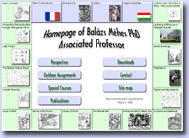

Perspective
Constructions
¤ Perspective Reconstruction
¤ First Cube as Extreme Cube
¤ Focusing Target Corner
¤ Cast Shadows by Freehand
¤ Windows
¤ Building and Plants
Outdoor Assignments
Special Courses
Publications
PERSPECTIVE RECONSTRUCTION in FREEHAND of VOLUMES and SPACES DETERMINED by ORTHOGONAL PICTURES |
||
Key-words: the Diagonal Method, the Framing Shape, a Structural Web of Basic Lines, Orthogonal Pictures, Surface subdivisions, the Vanishing Point. |
||
Summary |
||
The essential of my procedure developed for freehand rendering is that the volume or space to be depicted in perspective should be first enframed into a cubic web. To begin with we cover up all its orthogonal pictures with an appropriate quadratic grid. Then we have to create by freehand the first cube in correct perspective, corresponding to our choosen view-point. The rest of the cubic grid might be constructed by using the "diagonal method" (when corners are reflected through opposite halving points in order to multiply the grid). This simple method also helps us to obtain further details by accurate construction. Slopes, curves and other differences in the basic web should be related to this "scaffolding" composed of structural cubic units. |
||
The most delicate part in the procedure is to guess the depth of the first cube. My experiments (about the case with one vanishing point only) show that there seems to be a vague connection between the choosen vanishing point and the virtual height (Y) of the first cube's foreshortening square. |
||
Let's subdivide the frontal plane of the starting cube into three zones! |
||
In one vanishing point perspective the virtual height (Y) of the first cube's less distorted plane is approximately |
||
|
||
related to the original edge' size. |
||
© All rights reserved Associated Professor Balazs Mehes PhD recommended resolution 1024×768 |
||
_kis.jpg)